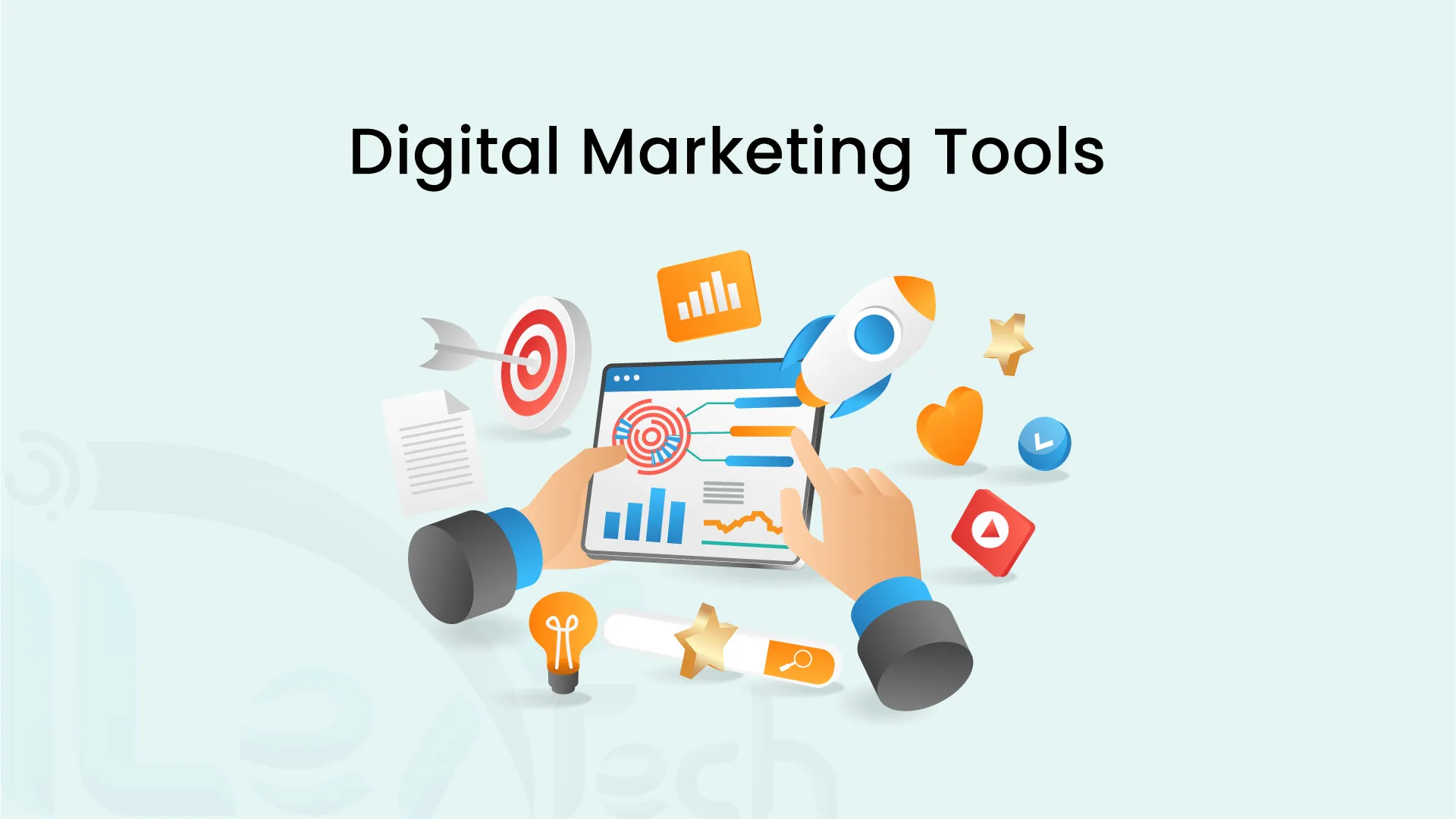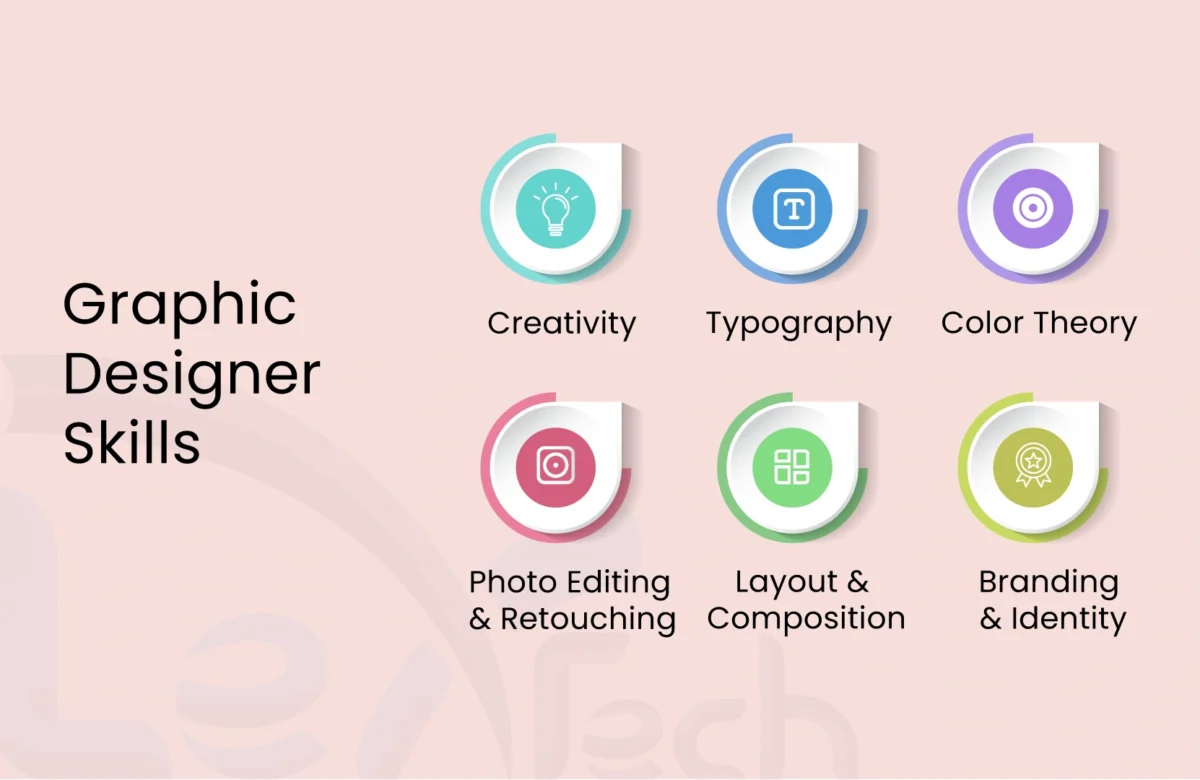Digital marketing in 2025 relies on using the right tools to achieve success. These tools help you streamline tasks, enhance campaigns, and drive better results. So, from optimizing SEO to managing social media and automating email campaigns, the right solutions can transform your marketing strategy. We’ve compiled a list of 30+ essential digital marketing tools that you can use to boost productivity, improve ROI, and stay ahead of the competition. Take charge and improve your marketing game with these must-have tools!
What are Digital Marketing Tools?
Digital marketing tools are software applications that help marketers plan, execute, and analyze their online marketing campaigns more effectively. These tools help you streamline processes, save time, and provide valuable insights. The tools enable marketers to reach their goals faster.
You can use digital marketing tools to manage social media platforms, optimize websites for search engines, track customer interactions, and automate your email campaigns. They empower you to make data-driven decisions by offering detailed analytics and performance metrics.
Whether you’re building brand awareness, generating leads, or increasing sales, these tools enhance your ability to connect with your target audience. In short, by using the right digital marketing tools, you can optimize campaigns, refine strategies, and achieve better results. They are very helpful for marketers who aim to stay competitive in today’s digital world.
Digital Marketing Tools by Strategy
We’ve created a detailed list of tools to help you reach your goals, including free and freemium options for those on a budget. From managing customer relationships to converting leads and uncovering new marketing opportunities, this guide provides the foundation for a powerful marketing toolkit. Let’s learn about different types of digital marketing tools:
- Social media marketing tools
- Email marketing tools
- SEO (search engine optimization) tools
- Conversion optimization tools
- Lead enrichment tools
- Landing page and lead capture tools
- Graphic creation tools
How to Choose the Right Digital Marketing Tool
Here’s how you can choose the perfect digital marketing tool for your business:
- Identify Your Goals: Define what you want to achieve, such as increasing traffic, generating leads, or improving conversions.
- Understand Your Audience: Choose tools that align with your audience’s preferences and behavior patterns.
- Evaluate Features: Look for tools with features that meet your specific needs. For example, analytics, automation, or integrations.
- Check Compatibility: Make sure the tool integrates smoothly with your existing software or platforms.
- Test Usability: Opt for tools that are user-friendly and easy to navigate to save your time and efforts.
- Consider Your Budget: Balance the tool’s cost with the value it offers, and explore free or premium options if needed.
- Read Reviews: You need to look at user feedback to understand your tool’s performance and reliability.
- Use Free Trials: Test the tool to determine if it meets your expectations before committing to a purchase.
- Check Scalability: Choose tools that can grow with your business and adapt to future needs.
Our Recommended Digital Marketing Tools
Here are the best tools we recommend for each category to help you streamline your digital marketing strategy. We’ve included tools that are reliable, user-friendly, and effective.
- Social Media Marketing Tools: Hootsuite, Buffer, Sprout Social
- Email Marketing Tools: Mailchimp, ActiveCampaign, ConvertKit
- SEO Tools: Ahrefs, SEMrush, Google Search Console
- Conversion Optimization Tools: Hotjar, Optimizely, Crazy Egg
- Lead Enrichment Tools: Clearbit, ZoomInfo, Hunter
- Landing Page and Lead Capture Tools: Unbounce, Instapage, Leadpages
- Graphic Creation Tools: Canva, Adobe Spark, VistaCreate
Social Media Marketing Tools You Need in 2025
Social media is a critical component of any successful marketing strategy. With thousands of active users on platforms like Instagram, Facebook, and X, businesses have unparalleled opportunities to connect with their audience.
However, managing multiple platforms, creating engaging content, and analyzing performance can be overwhelming. That’s where social media marketing tools come in. They simplify your efforts, save time, and ensure you achieve measurable results. Also, you need to keep the 4Ps of marketing in mind while working on your social media.
Here are five essential social media marketing tools you should consider using in 2025.
1. Hootsuite
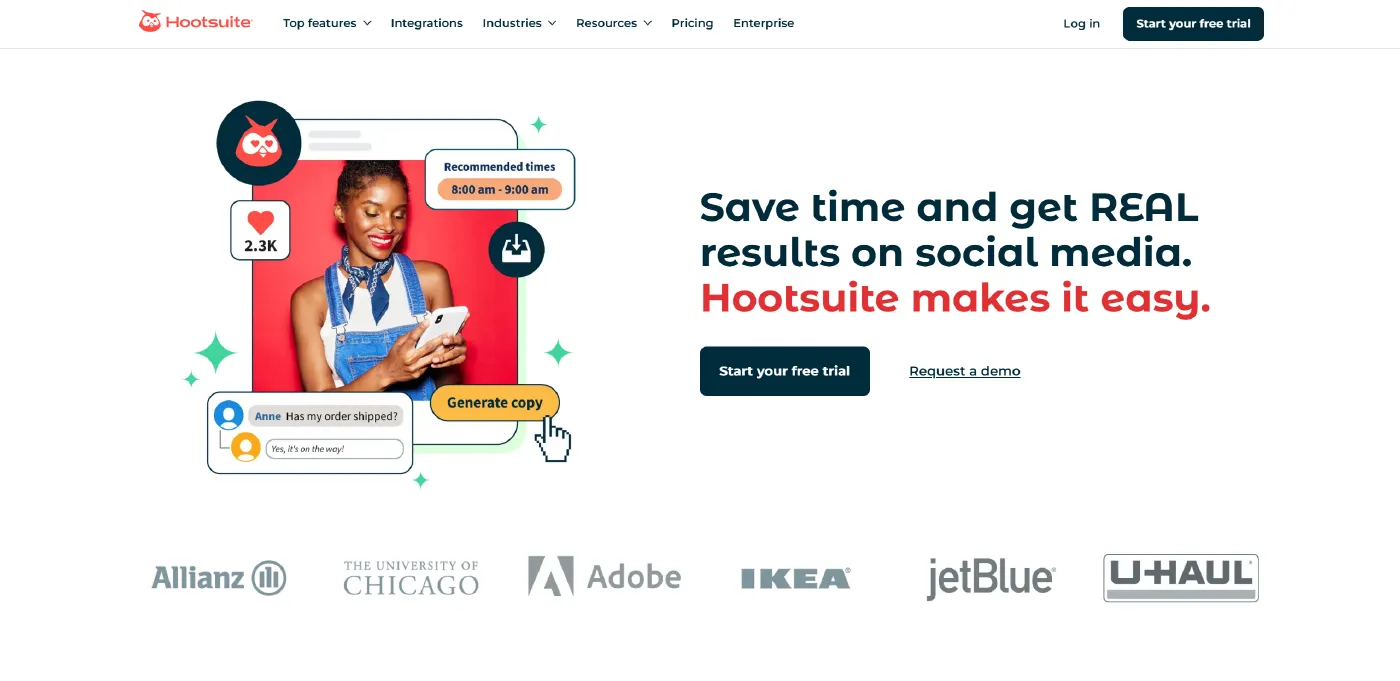
Hootsuite is a fantastic social media management tool that helps you stay organized while managing multiple platforms. It will allow you to schedule posts across platforms like Facebook, X, Instagram, and LinkedIn from a single space.
The tool also provides valuable analytics, showing which posts perform best and offering insights to improve engagement. Additionally, Hootsuite’s social listening feature helps you track mentions of your brand, enabling you to respond promptly and build stronger relationships with your audience. With Hootsuite, you can manage your campaigns efficiently and gain the insights needed to refine your strategies.
2. Buffer
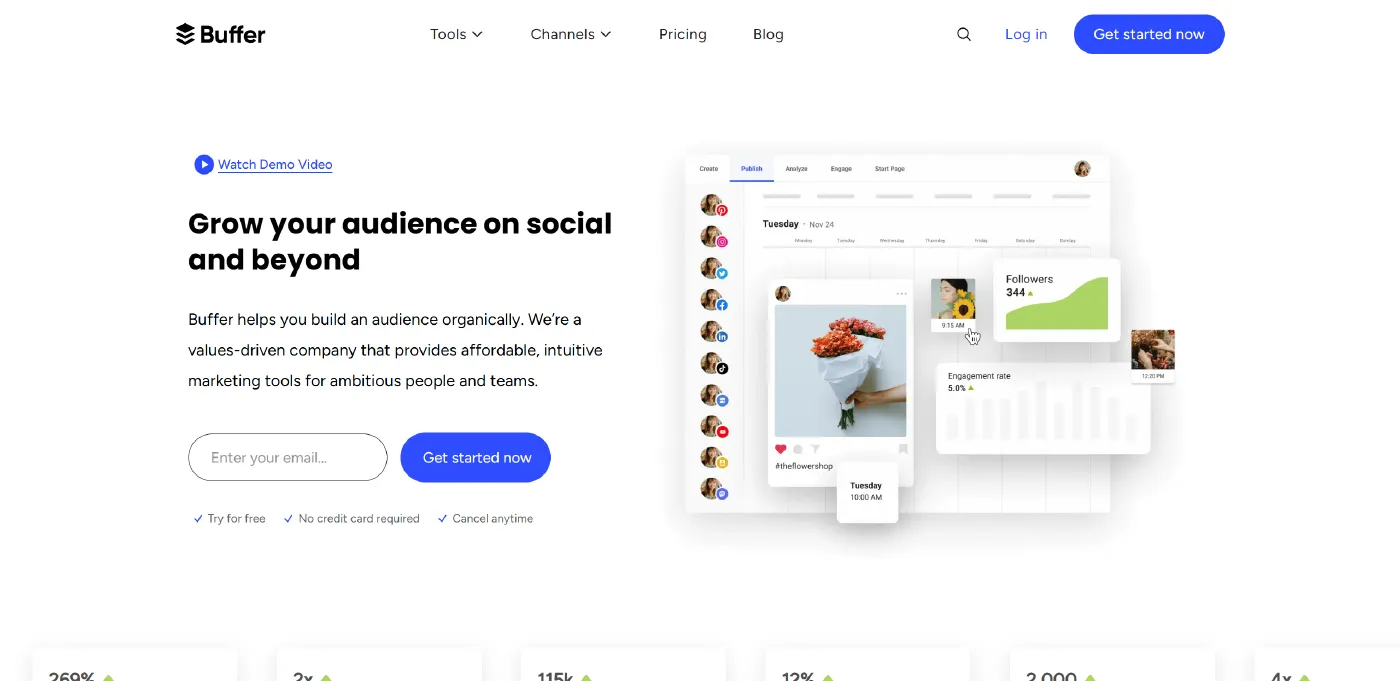
Buffer is another excellent tool that simplifies social media scheduling and publishing. Its user-friendly interface makes it easy to plan and schedule content in advance. Thus, the tool saves your time.
One unique feature is Buffer’s post-performance tracking. It provides data on likes, shares, clicks, and other metrics, helping you understand what resonates most with your audience. This data-driven approach ensures you’re not just posting but optimizing for better engagement.
Buffer also integrates seamlessly with popular platforms, making it a perfect choice for small businesses and solo marketers who want to manage social media effectively.
3. Sprout Social
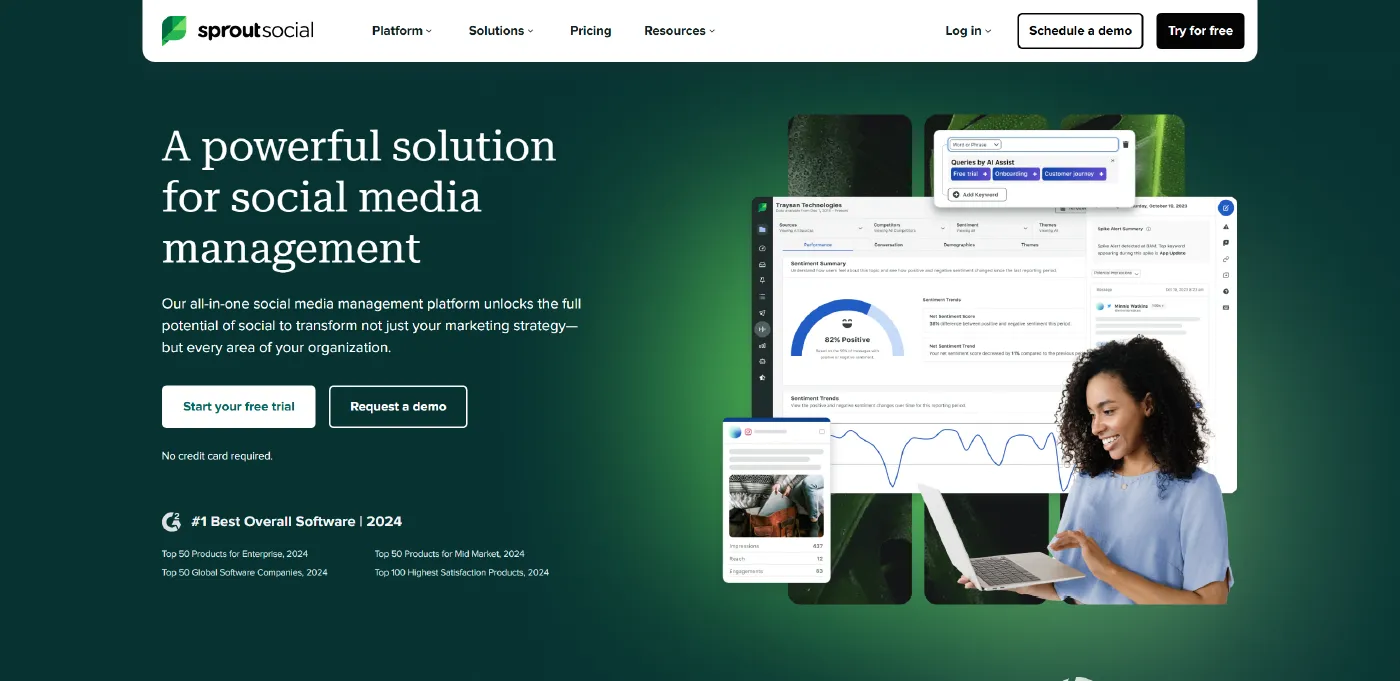
Sprout Social goes beyond basic scheduling by offering robust features for analytics, reporting, and social listening. Its analytics provide a deep dive into your social media performance, helping you identify trends and adjust your strategy.
Sprout Social’s social listening capabilities are particularly powerful. You can track industry keywords, monitor your competitors, and uncover opportunities to engage with your audience. This tool enables you to stay ahead of trends and make data-driven decisions.
With Sprout Social, you can manage your social media presence more effectively, whether you’re running campaigns for a small business or a large enterprise.
4. Later
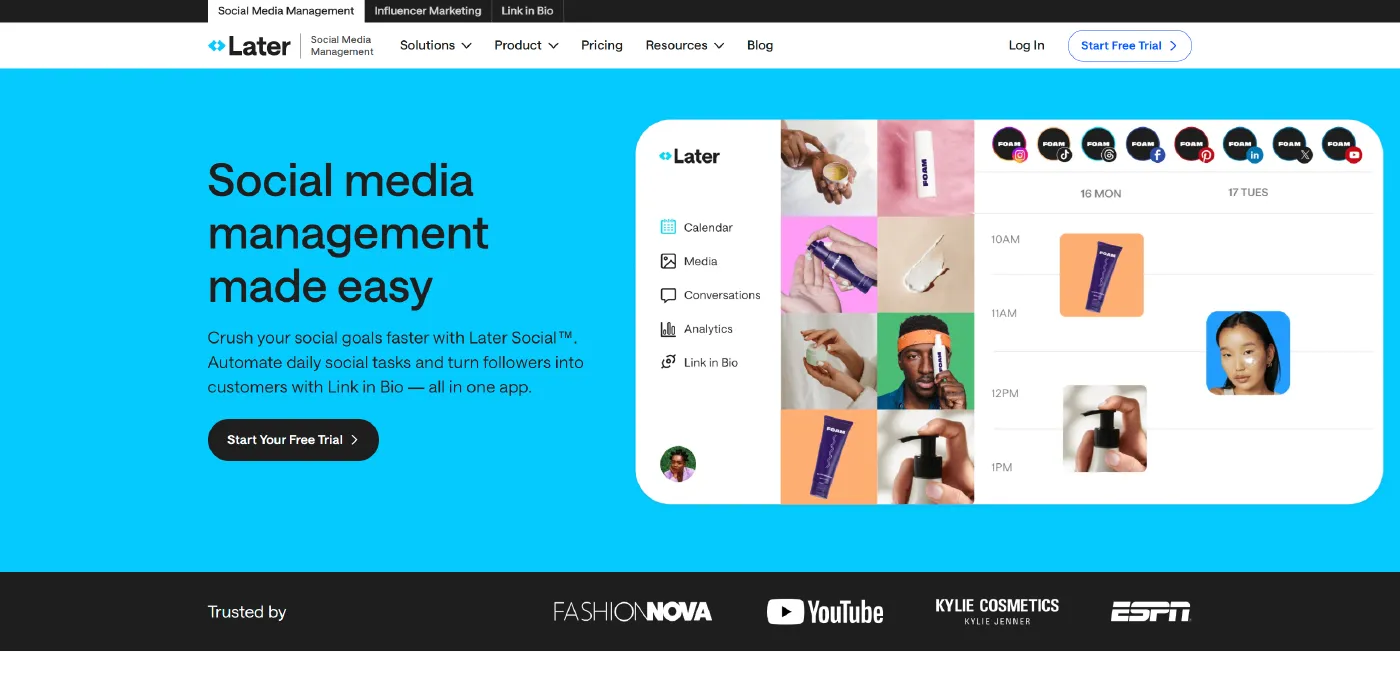
If Instagram is a major part of your social media strategy, Later is the tool for you. It specializes in Instagram scheduling and offers features like a visual content calendar, hashtag suggestions, and analytics to boost your campaigns.
Later’s drag-and-drop feature makes content planning intuitive. You can preview how your Instagram feed will look, ensuring your posts align with your brand’s aesthetic. The tool also provides performance insights to help you track growth and engagement.
Later isn’t just limited to Instagram—it also supports platforms like Pinterest, TikTok, and Facebook, making it a versatile option for visual content marketing.
5. Canva for Social Media
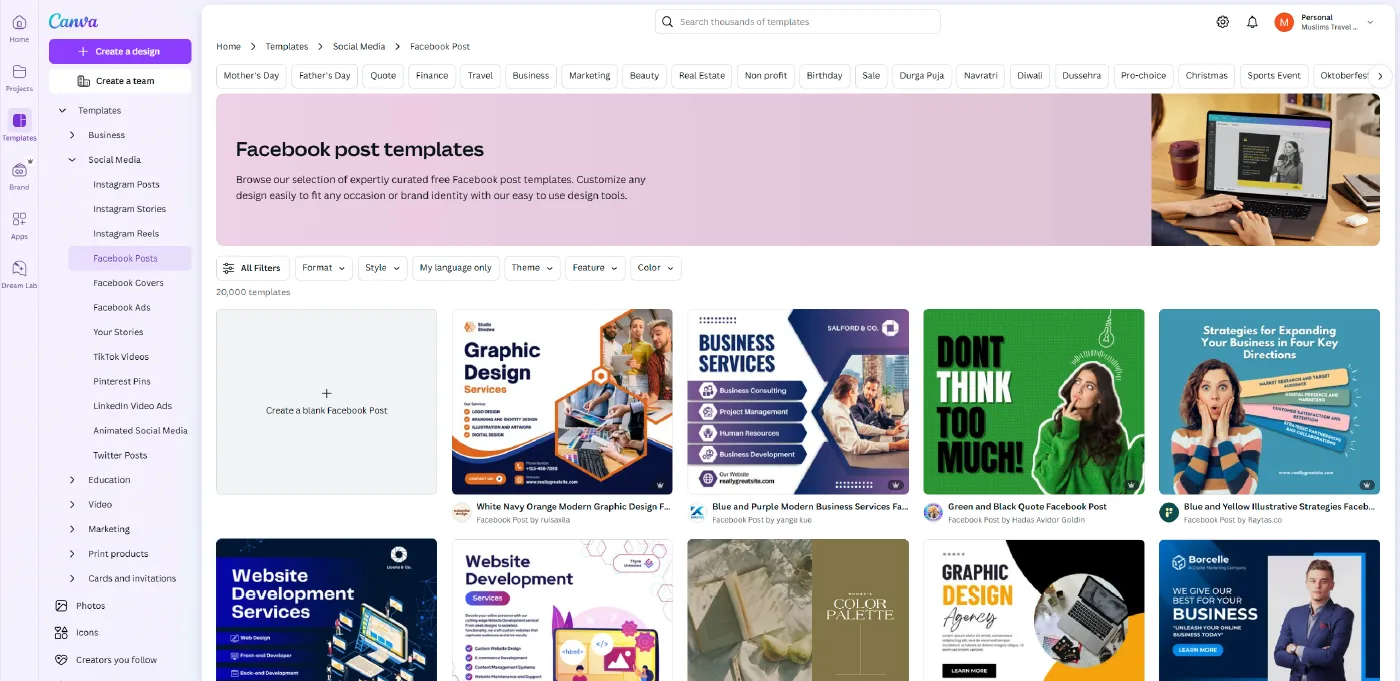
Canva, known for its graphic design capabilities, is a must-have tool for creating stunning social media visuals. Its pre-designed templates are tailored for platforms like Instagram, Facebook, and LinkedIn, allowing you to create professional-quality posts quickly.
What sets Canva apart is its simplicity. You don’t need graphic design experience to create eye-catching visuals. With drag-and-drop functionality and a vast library of elements, Canva makes designing easy and enjoyable.
Canva also integrates with social media scheduling tools, enabling you to design and publish content directly from the platform. It’s an excellent choice for businesses that want to elevate their visual content effortlessly.
Email Marketing Tools for the Email Marketers
Email marketing remains one of the most effective ways to connect with your audience, nurture leads, and drive sales. However, managing email campaigns manually can be time-consuming and prone to errors. That’s where email marketing tools come in.
These tools simplify campaign creation, automate repetitive tasks, and provide valuable insights to improve your results. Thus, the right email marketing tools will help you stay ahead in the competitive digital landscape. Let’s explore five email marketing tools.
6. Mailchimp
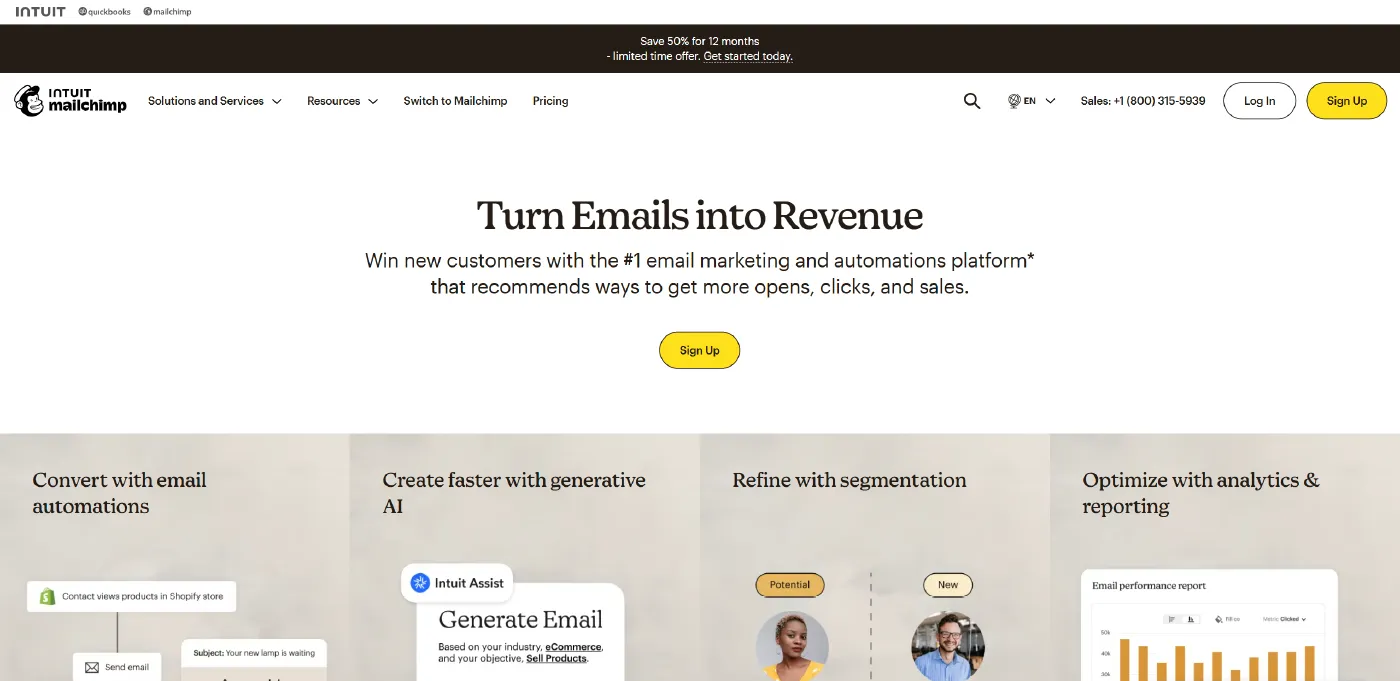
Mailchimp is one of the most popular email marketing tools, and for good reason. It offers an intuitive platform that allows you to design, automate, and track email campaigns effortlessly. Whether you’re a small business or a large enterprise, Mailchimp has something to offer.
One of its standout features is its drag-and-drop email builder, which makes it easy to create professional-looking emails without any coding experience. Mailchimp also provides audience segmentation, enabling you to send personalized messages to specific groups for better engagement.
Its analytics tools are another highlight. You can track metrics like open rates, click-through rates, and conversions, helping you understand what’s working and what needs improvement. With both free and paid plans, Mailchimp is accessible to marketers at any stage.
7. ActiveCampaign
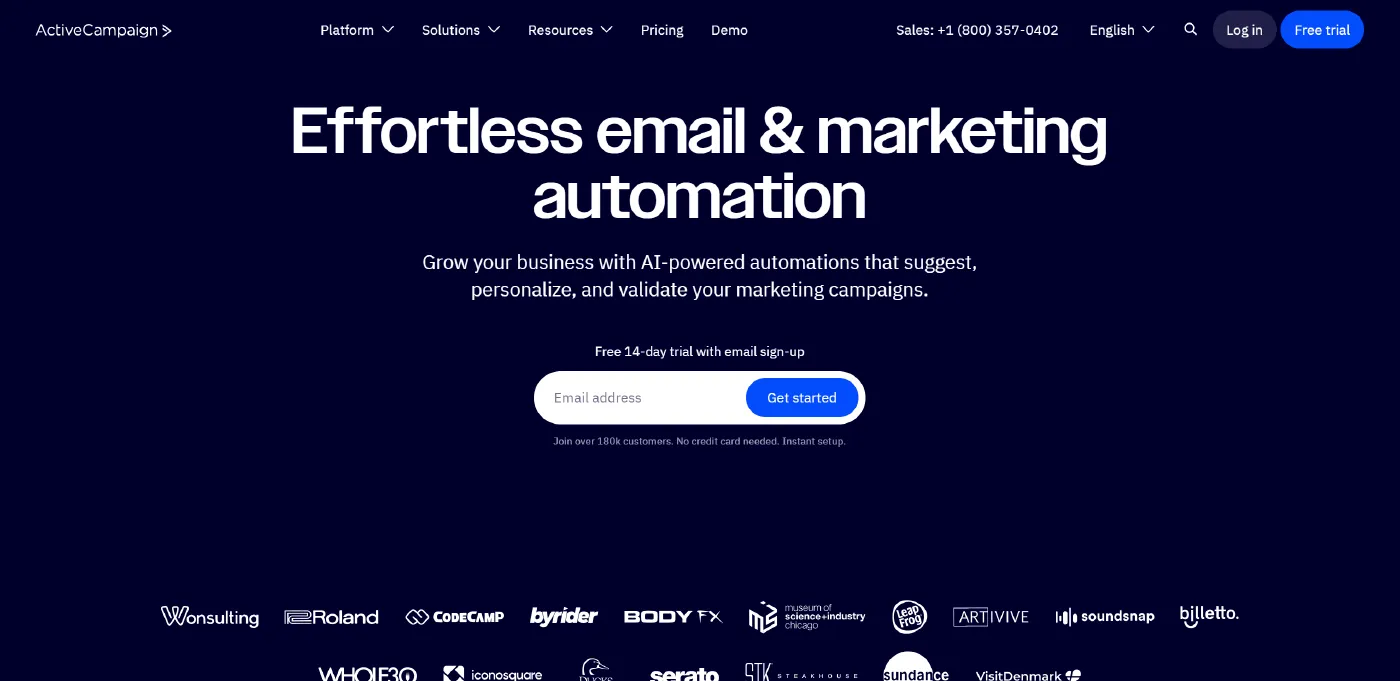
ActiveCampaign combines email marketing components with powerful customer relationship management (CRM) features. This tool is perfect if you want to create highly personalized email campaigns and automate your customer journey.
With ActiveCampaign, you can set up automation workflows based on user behavior, such as website visits or previous email interactions. This ensures your messages reach your audience at the right time with the right content. Its advanced segmentation options allow you to target your audience with precision, increasing the likelihood of conversions.
Additionally, ActiveCampaign’s reporting tools provide insights into campaign performance, helping you refine your strategy over time. If you’re looking for a tool that goes beyond basic email marketing, ActiveCampaign is an excellent choice.
8. ConvertKit

If you’re a content creator, blogger, or small business owner, ConvertKit is designed with you in mind. This email marketing tool focuses on simplicity and functionality, making it easy to build email lists and engage your audience.
ConvertKit’s standout feature is its email automation builder. You can create custom workflows that guide subscribers through a journey tailored to their interests. It also offers landing page and form-building capabilities, helping you grow your email list seamlessly.
The tool’s clean and intuitive interface ensures that even beginners can use it effectively. Plus, ConvertKit provides actionable insights to help you understand subscriber behavior and optimize your campaigns. For creators looking to nurture their audience, ConvertKit is a must-have tool.
9. SendinBlue
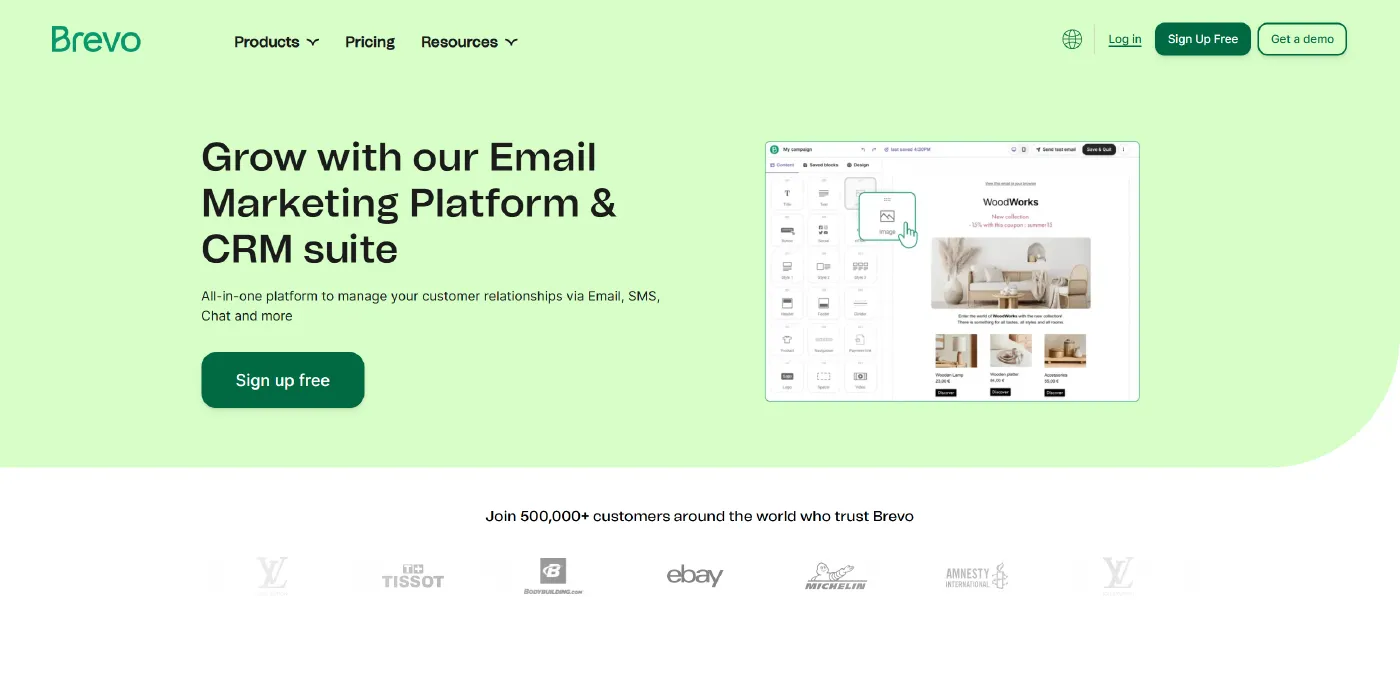
SendinBlue is an all-in-one marketing platform that combines email marketing, SMS campaigns, and CRM tools. Its new name is ‘Brevo’. Also, it’s a great option if you’re looking for a versatile tool to manage multiple aspects of your marketing strategy.
The email editor is straightforward and packed with features, allowing you to create visually appealing emails in minutes. SendinBlue also offers advanced automation, enabling you to send personalized messages based on triggers like sign-ups or purchases.
Another advantage of SendinBlue is its real-time reporting. You can monitor open rates, click-through rates, and deliverability, helping you adjust your campaigns for maximum impact. Its affordable pricing plans make it an attractive option for businesses of all sizes.
10. Constant Contact
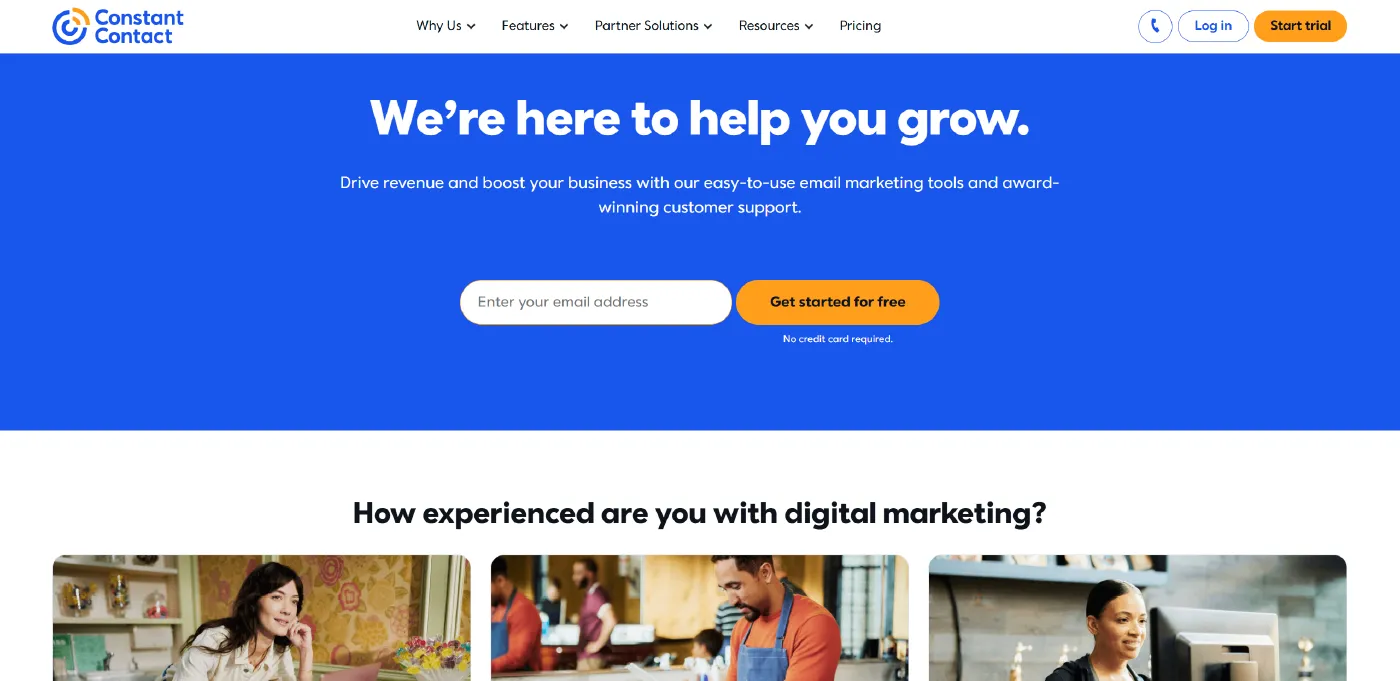
Constant Contact is a reliable tool that has been helping businesses with email marketing for years. Its focus on ease of use and customer support makes it a popular choice, especially for small businesses.
The platform provides a variety of customizable templates so you can create emails that align with your brand. It also offers automation features like autoresponders, which save time and ensure consistent communication with your subscribers.
Constant Contact’s analytics dashboard gives you a clear picture of your campaign’s performance, showing you what’s driving engagement and what needs tweaking. Additionally, the tool integrates with popular apps and platforms.
People Also Read: Understanding the Basic to Advance Components of Digital Marketing
Best Tools to Supercharge Your SEO Strategy in 2025
Search Engine Optimization (SEO) is a crucial part of digital marketing. It ensures that your website ranks higher in search engine results, driving organic traffic and increasing visibility. However, mastering SEO without the right tools can feel overwhelming. That’s why SEO tools are essential—they simplify keyword research, track rankings, analyze competitors, and optimize your site for better performance. Here are the five must-have SEO tools for 2025 for you!
11. Ahrefs
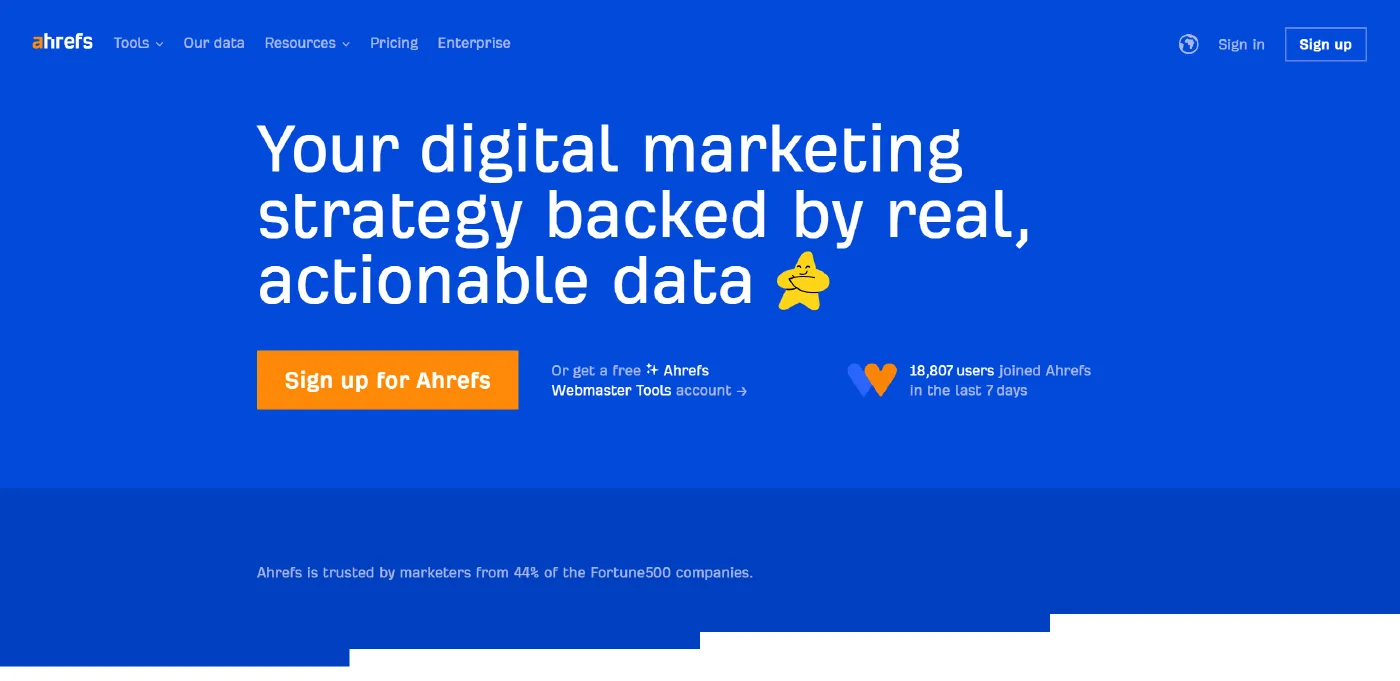
Ahrefs is one of the most powerful SEO tools available, offering an all-in-one solution for marketers looking to improve their search rankings. With its user-friendly interface and robust features, Ahrefs is perfect for both beginners and experienced professionals.
One of its standout features is the Site Explorer, which provides a detailed analysis of your website’s backlinks, organic keywords, and competitor data. You can identify which websites are linking to you, what keywords are driving traffic, and how your competitors are performing.
Ahrefs also offers a Keyword Explorer tool that helps you find the best keywords for your niche. It provides data on search volume, keyword difficulty, and potential traffic, ensuring you target the right terms. Whether you’re building a strategy from scratch or refining an existing one, Ahrefs gives you the insights you need to succeed.
12. SEMrush
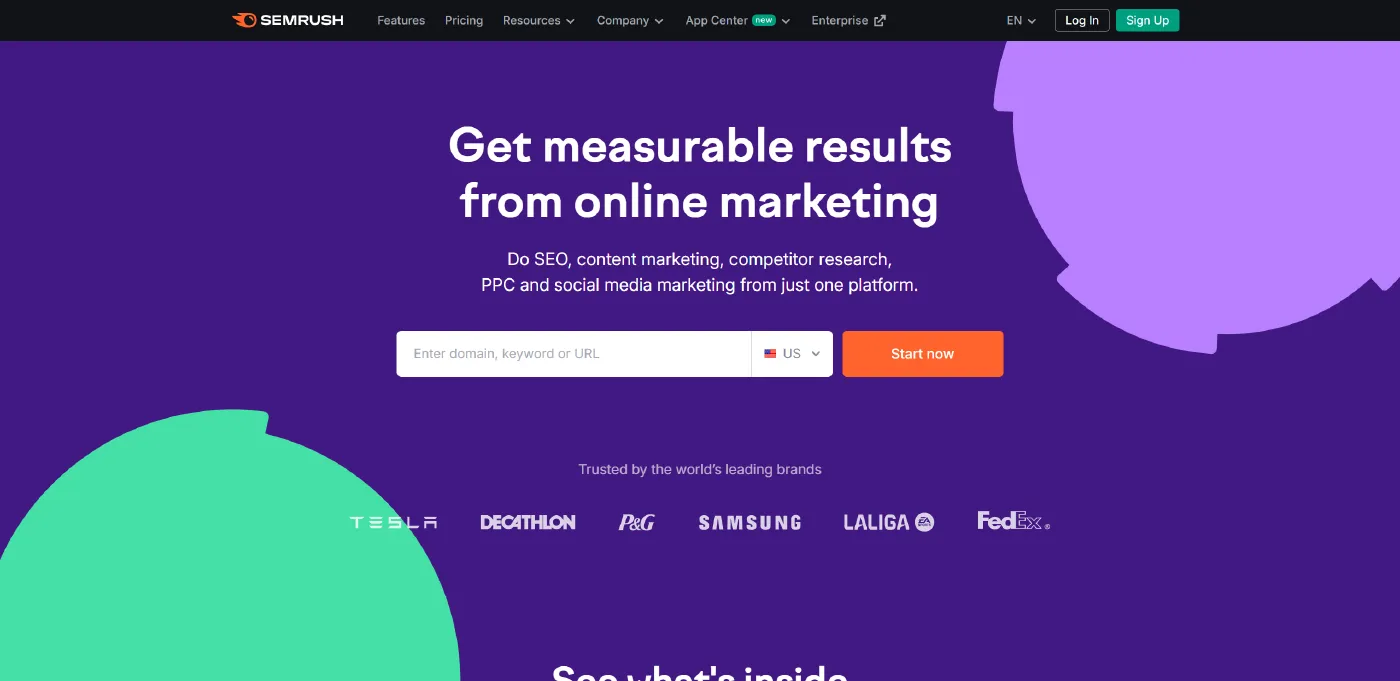
SEMrush is another top-tier SEO tool known for its comprehensive features. It’s especially useful if you want to analyze your competitors while optimizing your own strategy.
With SEMrush, you can conduct in-depth keyword research to find terms that align with your goals. Its Position Tracking feature allows you to monitor your website’s rankings for specific keywords, helping you measure the impact of your efforts over time.
SEMrush also excels in content optimization. The SEO Writing Assistant provides real-time suggestions to improve your content’s readability, keyword density, and overall structure. This ensures your content is not only engaging but also optimized for search engines.
Additionally, SEMrush’s Site Audit feature identifies technical issues on your website, such as broken links, slow loading speeds, or missing meta descriptions. Fixing these problems can significantly improve your search engine performance.
13. Google Search Console

Google Search Console is a free tool provided by Google to help website owners monitor and optimize their site’s performance in search results. While it doesn’t offer as many features as paid tools, it’s an essential resource for any SEO strategy.
One of its key features is the ability to track your website’s search performance. You can see how often your site appears in search results, what keywords are driving clicks, and where your pages rank. This data helps you understand what’s working and where you need to improve.
Google Search Console also alerts you to technical issues, such as crawl errors or mobile usability problems. By addressing these issues promptly, you ensure that your site remains accessible and user-friendly.
Another advantage is the URL Inspection Tool, which allows you to check if individual pages are properly indexed by Google. This helps you identify and fix indexing problems that might be affecting your visibility.
14. Yoast SEO
If you’re using WordPress for your website, Yoast SEO is a must-have plugin. It simplifies on-page optimization, making it easier to ensure your content meets SEO best practices.
Yoast SEO offers real-time suggestions for improving your content. For example, it checks keyword usage, readability, and meta tags to help you create pages that rank well. It even provides a readability score based on factors like sentence length and subheading use, ensuring your content is easy to digest.
Another standout feature is the XML sitemap generator, which automatically creates a sitemap for your site. This makes it easier for search engines to crawl and index your content.
In short, with its intuitive interface and practical features, Yoast SEO is perfect for marketers who want to optimize their content without getting bogged down in technical details.
15. Moz Pro

Moz Pro is a versatile SEO tool that offers solutions for keyword research, site audits, and link building. Its goal is to help you improve your website’s visibility and attract more organic traffic. The Keyword Explorer feature is a highlight, offering detailed data on keyword difficulty, potential traffic, and related terms. This helps you prioritize the keywords that will deliver the best results.
Moz Pro’s Link Explorer is another valuable tool. It analyzes your site’s backlink profile, showing you which links are helping your rankings and identifying potential opportunities for improvement.
The Site Crawl feature identifies technical SEO issues, such as duplicate content, missing tags, or slow-loading pages. Moz Pro also provides actionable recommendations to help you fix these problems quickly.
Conversion Optimization Tools to Boost Your Results in 2025
Conversion optimization is all about turning website visitors into customers or leads. Whether you’re running an online store, generating leads, or growing your audience, optimizing your website’s performance can make all the difference. Conversion optimization tools help you understand user behavior, identify areas for improvement, and test changes to achieve better results. Check out these powerful conversion optimization tools.
16. Hotjar
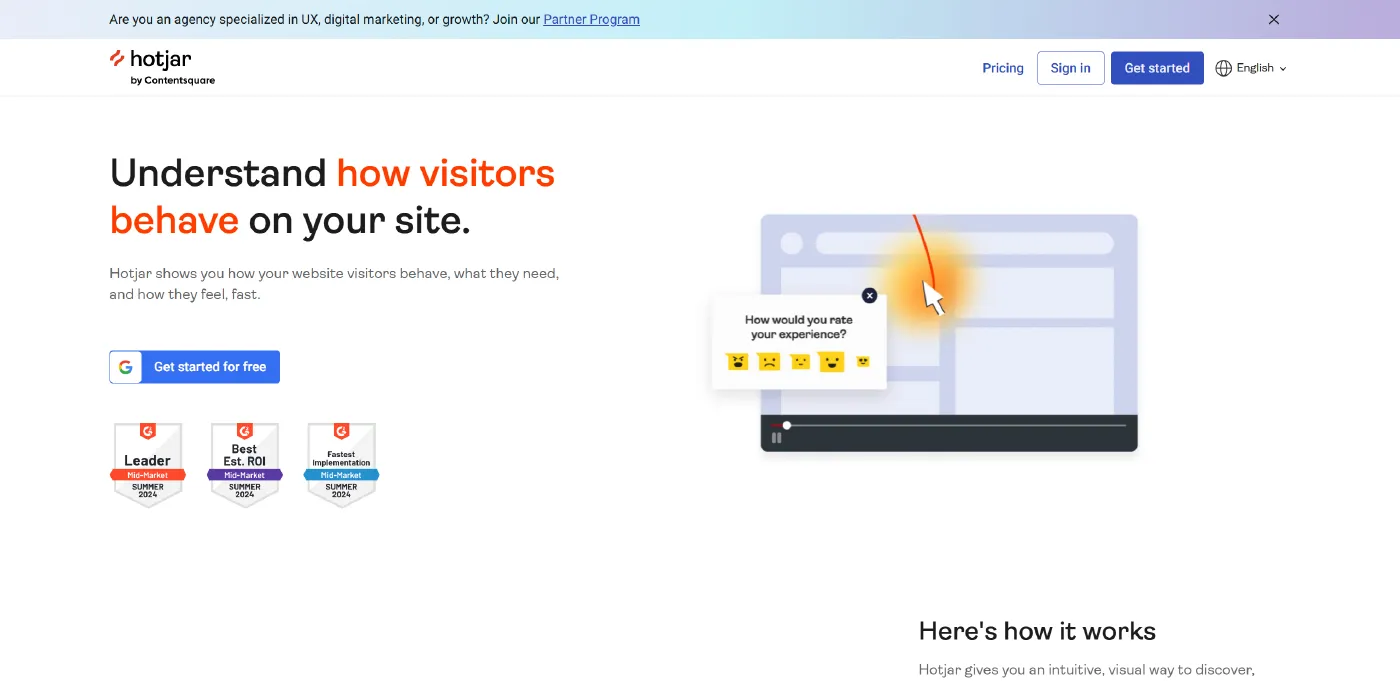
Hotjar is one of the most popular tools for understanding user behavior on your website. It provides heatmaps, session recordings, and surveys to show you exactly how visitors interact with your site.
The heatmaps highlight where users click, scroll, and spend time on each page. This data helps you identify which elements grab attention and which ones are being ignored. Hotjar’s session recordings let you replay real user interactions, revealing potential frustrations or roadblocks in the user journey.
Another useful feature is the survey tool, which allows you to collect direct feedback from visitors. This insight can help you improve user experience and address concerns before they lead to lost conversions. Hotjar’s intuitive interface and actionable data make it a must-have tool for anyone focused on improving website performance.
17. Google Optimize
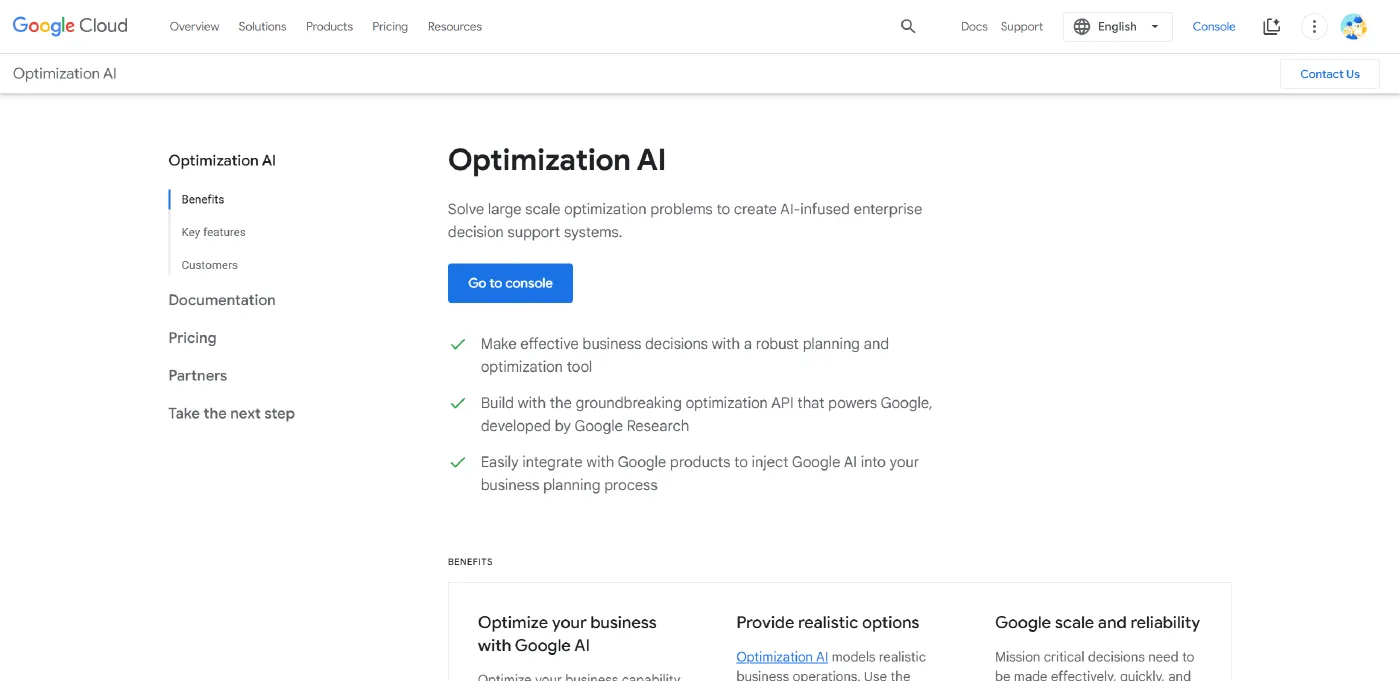
Google Optimize is a free yet powerful tool for A/B testing and personalizing website experiences. It integrates seamlessly with Google Analytics, giving you access to detailed user data to test new ideas effectively.
With Google Optimize, you can run A/B tests to compare two or more versions of a page. For example, you can test different headlines, images, or calls to action to see which performs better. You can also create personalized experiences by targeting specific audience segments based on their location, behavior, or device type.
Its integration with other Google tools, like Ads and Tag Manager, makes it especially useful for marketers already invested in the Google ecosystem. Whether you’re a beginner or an advanced marketer, Google Optimize provides the tools you need to refine your website and boost conversions.
18. Optimizely
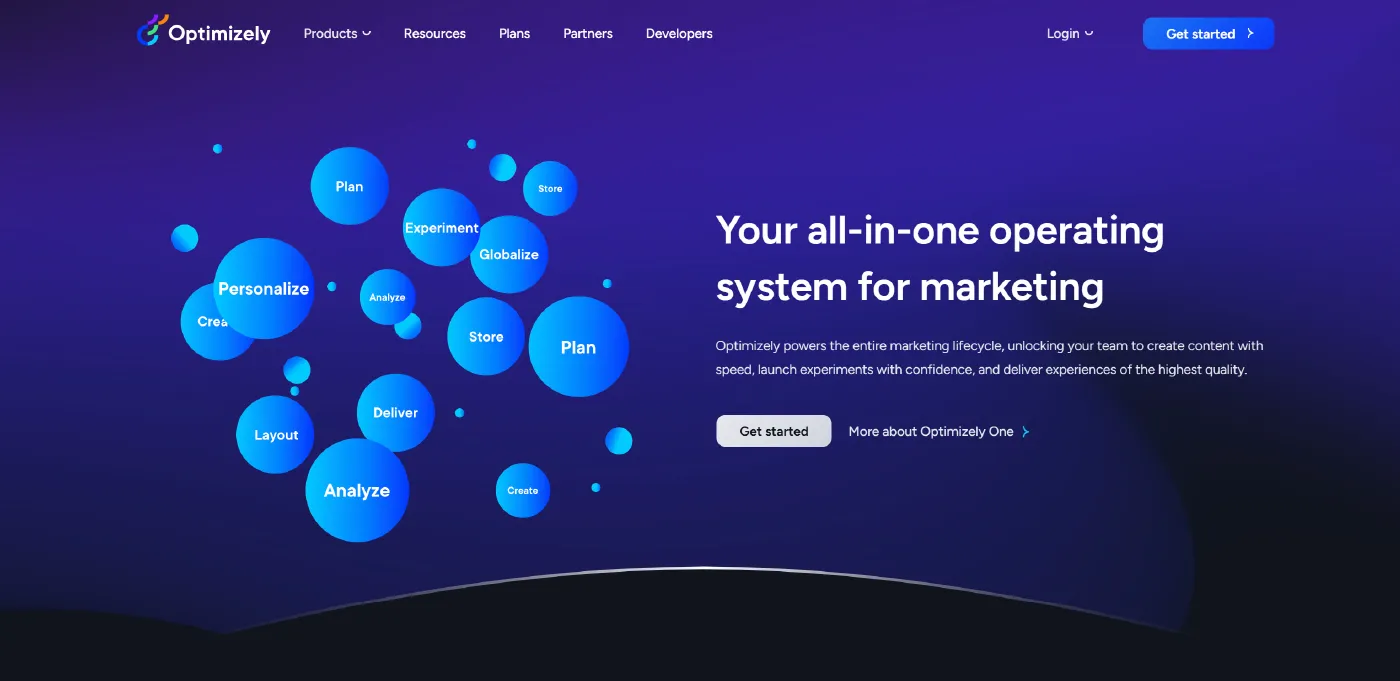
Optimizely is a comprehensive platform for experimentation and optimization. It allows you to test changes to your website, mobile app, or other digital properties to identify what drives the best results.
The platform’s visual editor makes it easy to create and run experiments without needing coding skills. For instance, you can change button colors, swap out images, or rearrange page elements to see how these adjustments impact user behavior.
Optimizely also supports multivariate testing, enabling you to test multiple variations at once. This is particularly useful for understanding the combined effects of different design or content changes. With its robust analytics and AI-driven recommendations, Optimizely helps you make data-backed decisions to improve conversions.
19. Crazy Egg
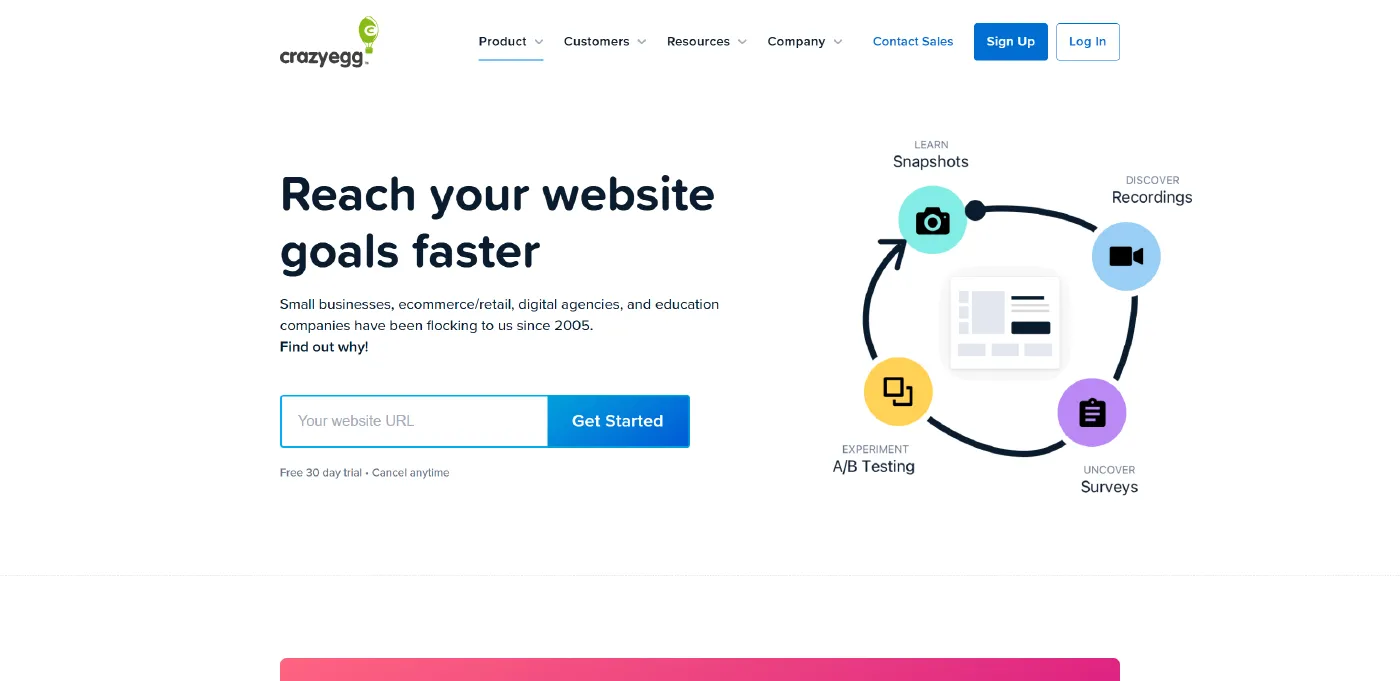
Crazy Egg simplifies conversion optimization by offering heatmaps, scrollmaps, and A/B testing tools. It shows you where visitors click, how far they scroll, and what content engages them the most.
The heatmaps provide visual insights into user interactions, while the scrollmaps show which parts of your pages hold visitors’ attention. This information is invaluable for identifying underperforming areas and adjusting to keep users engaged.
Crazy Egg also offers a user-friendly A/B testing tool. You can test changes like new headlines or layouts to determine what resonates best with your audience. Additionally, its simple setup process makes it easy for businesses of any size to get started with optimization.
20. VWO (Visual Website Optimizer)
VWO is a versatile conversion optimization platform designed for running A/B tests, multivariate tests, and split URL tests. It provides a range of tools to help you understand user behavior and improve your website’s performance.
With VWO’s behavioral insights, you can identify issues like high bounce rates or drop-offs in the user journey. Its testing capabilities allow you to experiment with changes and measure their impact on conversions. For example, you can test different pricing structures, navigation layouts, or product descriptions to find the most effective approach.
One standout feature is its ability to create targeted experiments for specific user segments. This ensures that your tests address the needs of different audience groups, leading to more personalized and effective experiences.
Lead Enrichment Tools to Supercharge Your Marketing in 2025
Lead enrichment is a critical step in modern marketing. It’s about gathering and enhancing information about your prospects to create personalized and effective outreach strategies. The more you know about your leads, the better you can engage them with the right message at the right time. Lead enrichment tools simplify this process by automating data collection, verification, and enrichment, saving you time and improving accuracy. So, here are five powerful lead enrichment tools you need in 2025 to transform your marketing efforts.
21. Clearbit
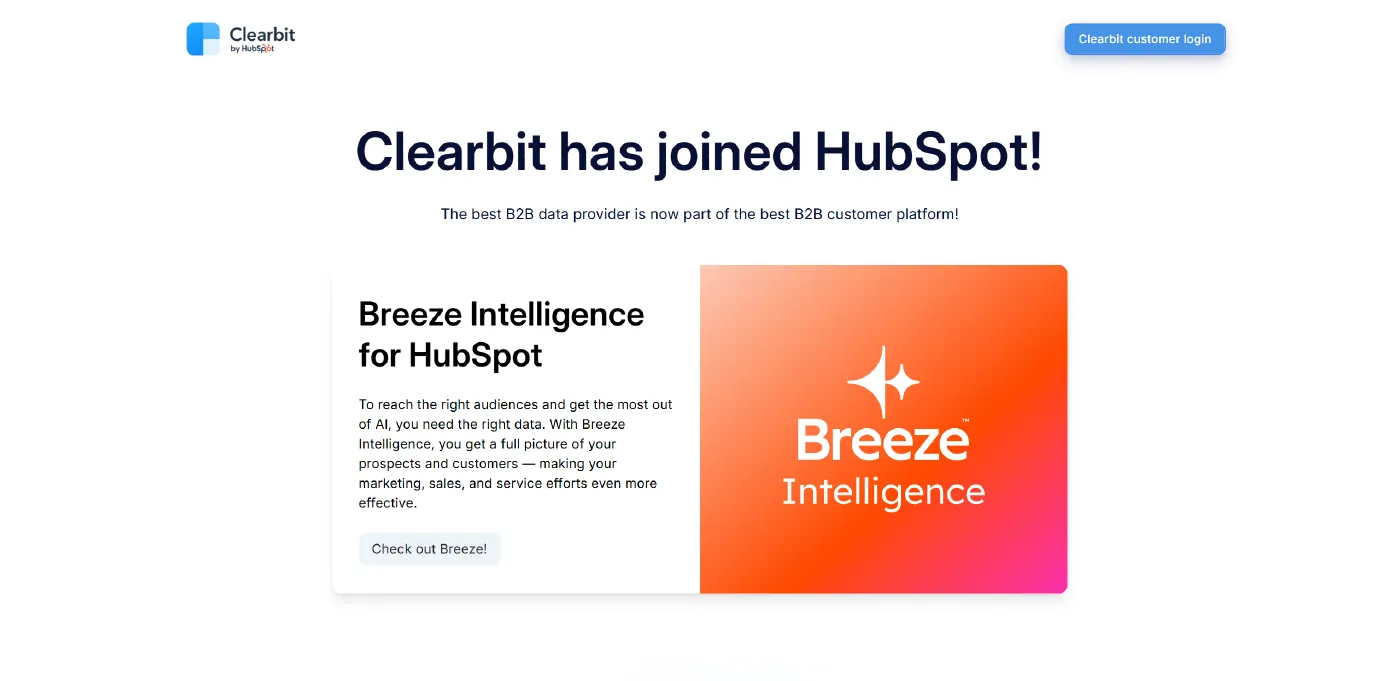
Clearbit is a leading lead enrichment tool that provides detailed information about your prospects. It integrates seamlessly with your CRM, enriching contact profiles with data such as company details, job titles, social media links, and more.
One of Clearbit’s standout features is its ability to fill in gaps in your data. For example, if you have a prospect’s email address but lack their company size or location, Clearbit can retrieve this information automatically.
Another advantage is its real-time data updates. This ensures your records are always current, helping you make informed decisions. Clearbit also integrates with tools like Salesforce and HubSpot, making it easy to use within your existing workflow.
Recommended for You: What is Digital Marketing Audit & How to Do It?
22. ZoomInfo
ZoomInfo is a robust platform for B2B lead enrichment, offering a vast database of business information. With ZoomInfo, you can access details about companies, decision-makers, and industry trends, giving you a competitive edge.
One of its key features is intent data, which helps you identify companies actively searching for solutions like yours. This allows you to target prospects at the perfect time, increasing your chances of conversion.
ZoomInfo also provides contact intelligence, such as direct phone numbers and email addresses, making it easier to reach the right people. Its integration with popular CRM systems ensures smooth data transfer, allowing your sales and marketing teams to work more efficiently.
23. Hunter
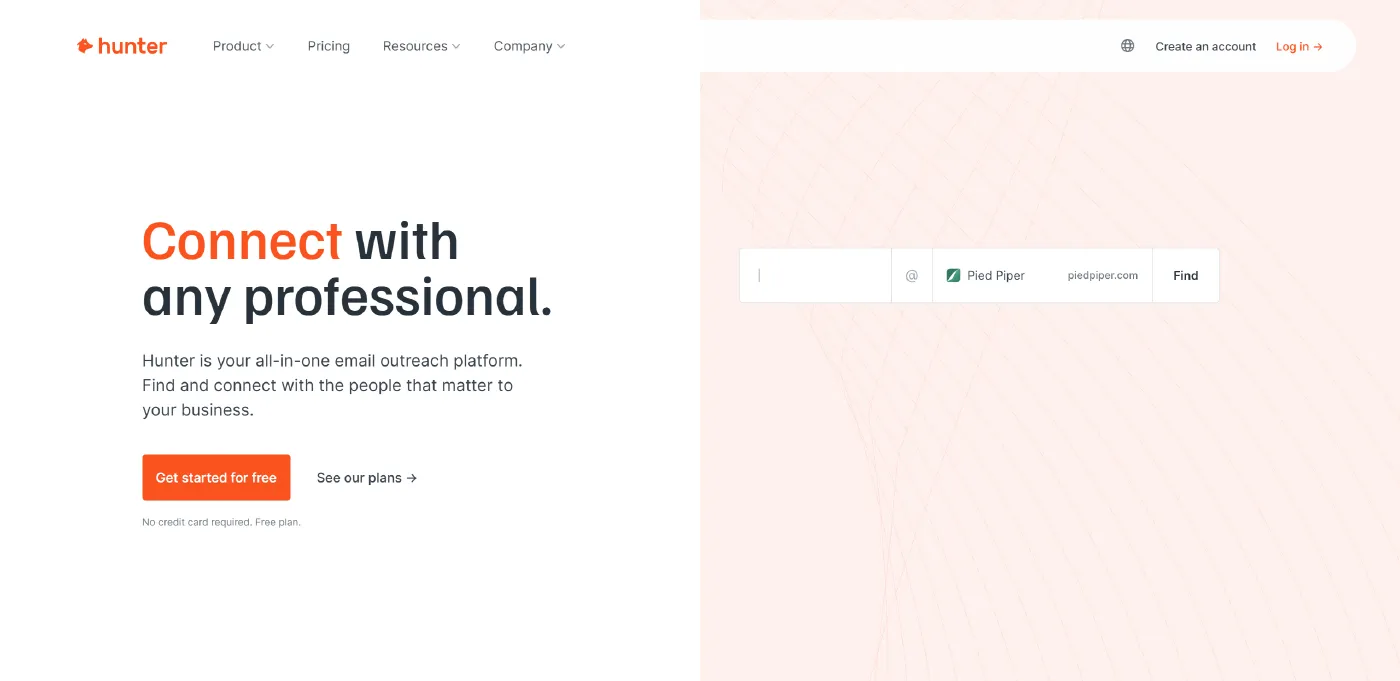
Hunter is an excellent tool for finding and verifying email addresses, making it a valuable resource for lead enrichment. Whether you’re trying to reach a specific contact or build a targeted email list, Hunter simplifies the process.
The tool allows you to search for email addresses by entering a company’s domain name. It scans publicly available sources to find relevant contacts and even provides an accuracy score to ensure you’re working with reliable data.
Hunter’s email verification feature is particularly useful. It checks the validity of email addresses, reducing the risk of bounces and improving your sender’s reputation. With its simple interface and straightforward pricing, Hunter is a great choice for businesses of all sizes.
24. Lusha
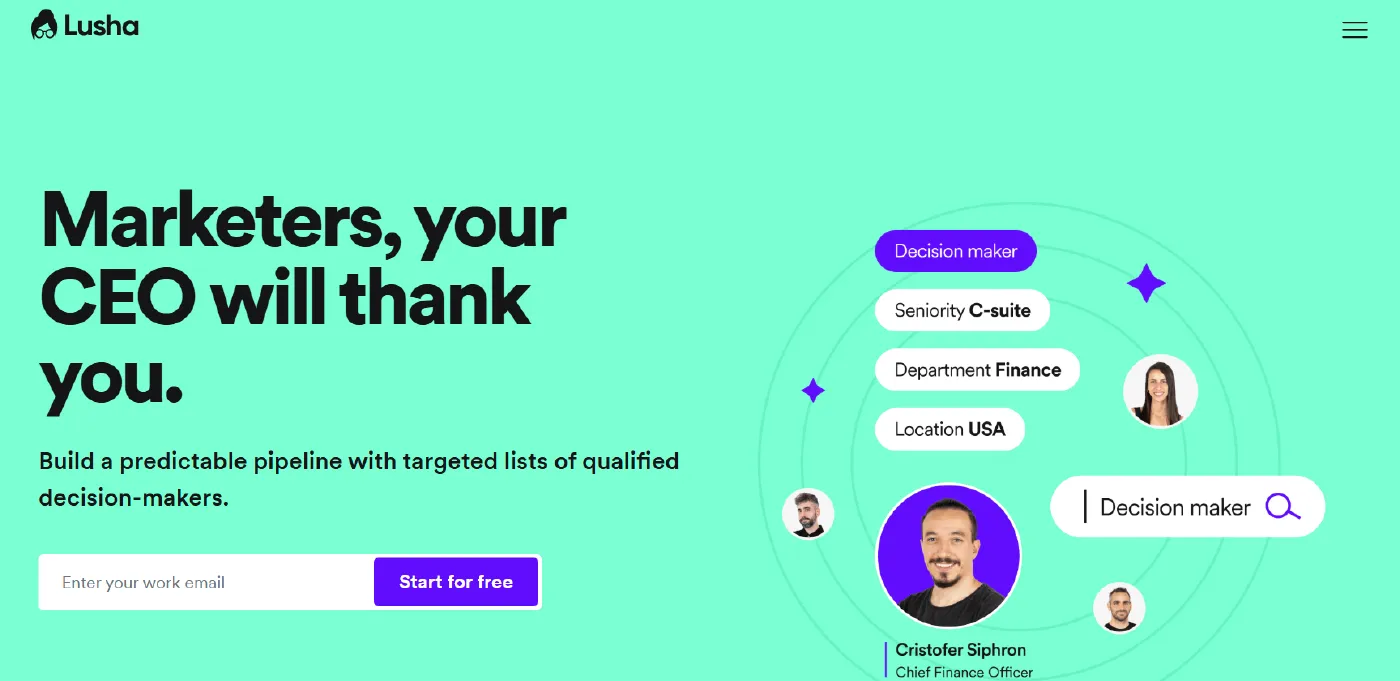
Lusha specializes in providing accurate and up-to-date contact information for B2B professionals. It’s designed to enrich your lead data with details such as phone numbers, email addresses, and company insights.
What sets Lusha apart is its focus on accuracy and compliance. It adheres to strict data privacy standards, ensuring you access reliable information while staying GDPR-compliant.
Lusha integrates with tools like LinkedIn, Salesforce, and HubSpot, making it easy to collect and enrich data directly from your favorite platforms. Its browser extension allows you to gather contact details instantly while browsing profiles or company websites, saving you time and effort.
25. Datanyze

Datanyze is a lead enrichment tool that focuses on technographics—data about the technology stack used by companies. This unique feature is particularly valuable for businesses selling tech solutions, as it helps you identify prospects already using similar tools.
Datanyze’s database provides insights into company size, revenue, location, and industry, enabling you to target leads that align with your ideal customer profile. The platform also offers contact information for decision-makers, helping you connect with the right people.
Its integration with popular CRM platforms ensures seamless data transfer, keeping your lead records enriched and updated. For tech-focused businesses, Datanyze is a game-changer for prospecting and lead qualification.
Landing Page and Lead Capture Tools for You
Landing pages are essential for driving conversions and capturing leads. They serve as the first point of contact for potential customers, helping you showcase your offer, build trust, and encourage action. When paired with the right lead capture tools, landing pages can help you collect valuable information like names, email addresses, and preferences to grow your audience and drive sales. Check these powerful landing pages and lead capture tools.
26. Unbounce
Unbounce is one of the most popular tools for building high-converting landing pages. It allows you to create and publish pages without needing any coding skills, making it perfect for marketers of all experience levels.
The drag-and-drop builder is intuitive and packed with features. You can easily add forms, buttons, images, and other elements to your page. Unbounce also offers a library of professionally designed templates, so you don’t have to start from scratch.
One standout feature of Unbounce is its Smart Traffic. This AI-powered tool analyzes visitor behavior and automatically directs them to the landing page most likely to convert. Additionally, Unbounce integrates seamlessly with marketing platforms like Mailchimp, Salesforce, and HubSpot, making it easy to sync your leads.
Recommended for You: What is a Digital Marketing Consultant & Why to Hire?
27. Instapage
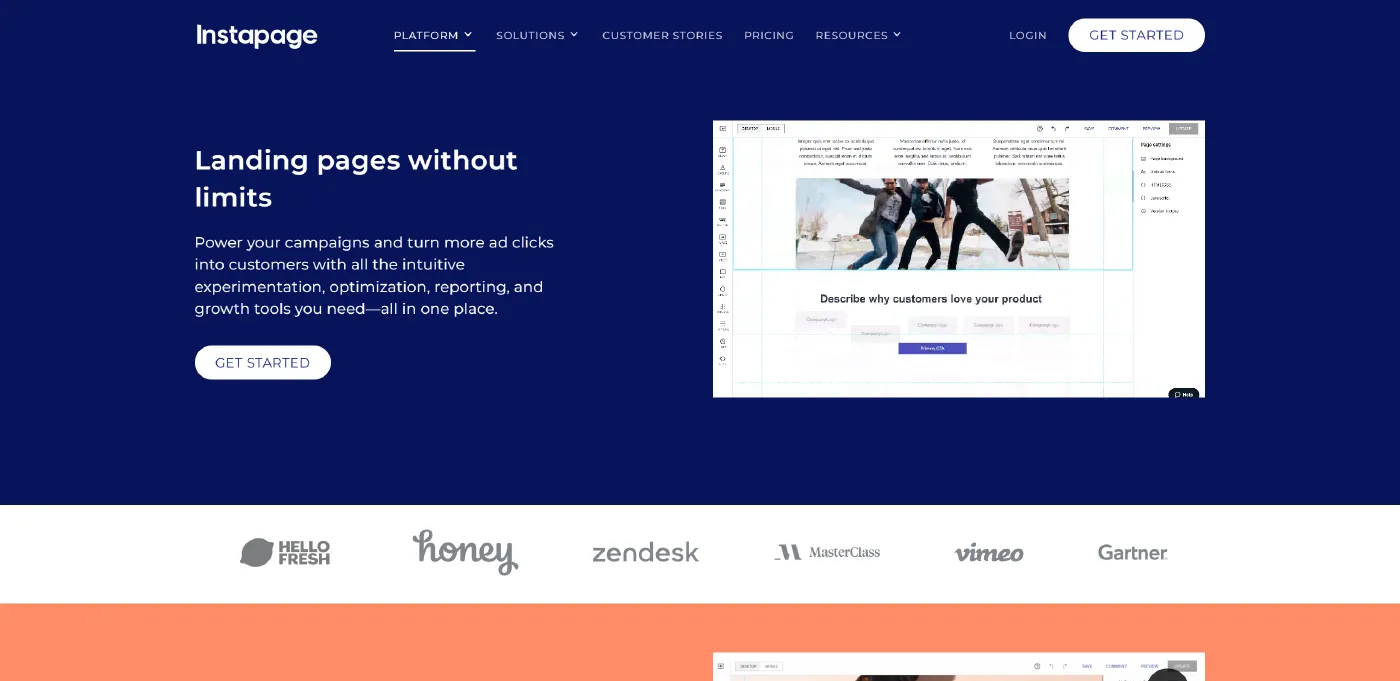
Instapage is another excellent tool for creating landing pages that convert. It’s known for its customization options and detailed analytics, which help you optimize your campaigns.
The platform’s drag-and-drop editor allows you to design pages quickly, even if you’re not tech-savvy. With over 500 templates to choose from, Instapage makes it easy to create pages tailored to your audience.
One of Instapage’s standout features is its A/B testing capability. You can test different versions of your landing pages to see which design, headline, or call-to-action performs best. It also provides heatmaps to show where visitors click, helping you identify areas for improvement.
Instapage integrates with a wide range of tools, including Google Ads, Zapier, and CRM platforms, ensuring a smooth workflow from lead capture to follow-up.
28. Leadpages
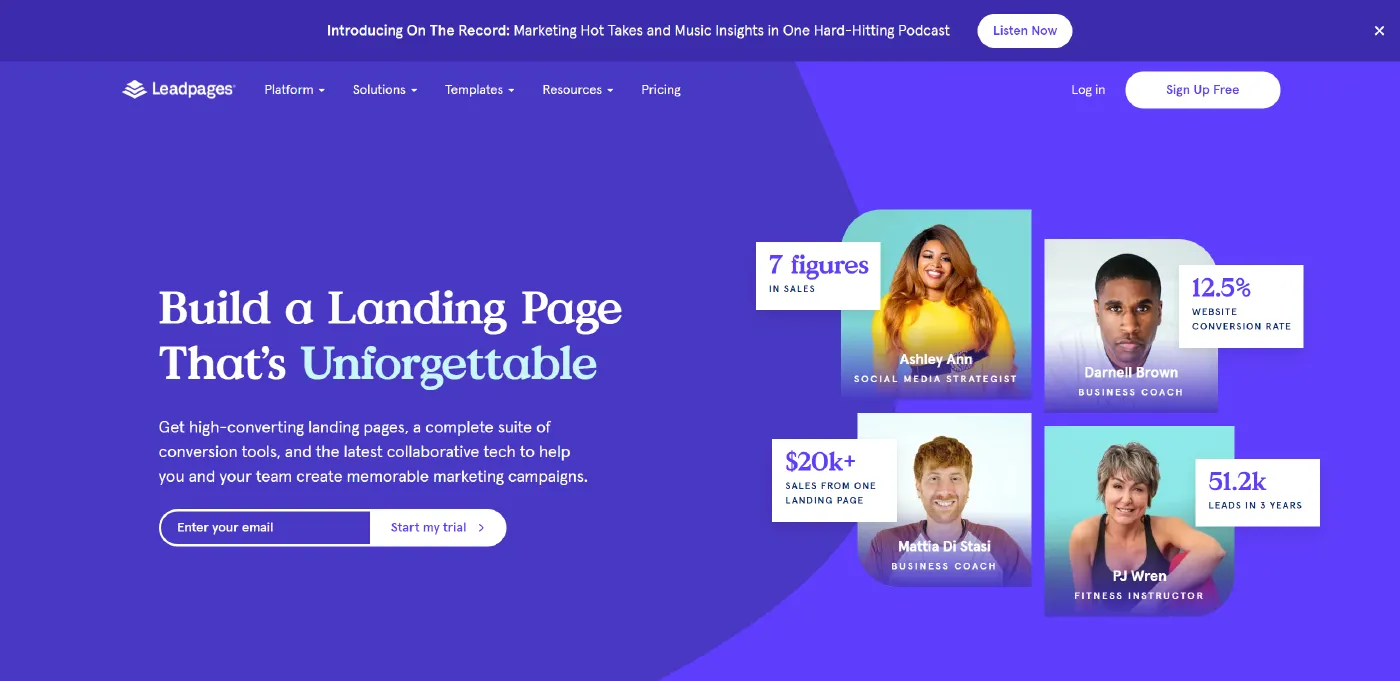
Leadpages is an affordable and user-friendly tool for creating landing pages and pop-up forms. It’s ideal for small businesses and startups looking for a cost-effective way to capture leads and grow their audience.
The platform offers ready-to-use templates optimized for different goals, whether you’re promoting a product, hosting an event, or building your email list. You can customize these templates using a simple drag-and-drop editor.
Leadpages also include lead capture forms and pop-ups, making it easy to collect contact information from your visitors. Additionally, its analytics dashboard helps you track performance and identify areas to improve.
With integrations for email marketing platforms like Mailchimp and Constant Contact, Leadpages ensures your leads are automatically added to your database.
29. OptinMonster
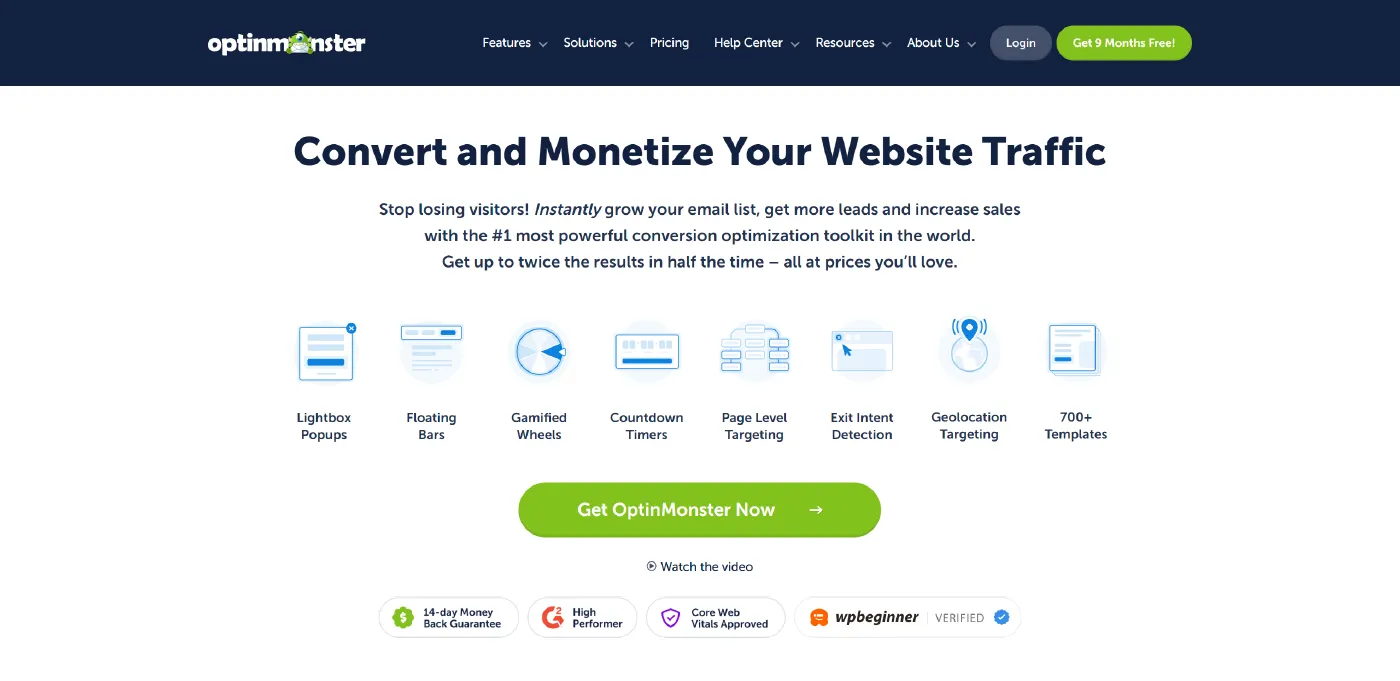
OptinMonster specializes in creating pop-ups, slide-ins, and other lead-capture forms to engage visitors and convert them into leads. It’s a great tool for adding lead capture functionality to your website without needing to create separate landing pages.
The platform offers a variety of pre-built templates for pop-ups, exit-intent forms, and more. Its drag-and-drop editor makes customization a breeze, and you can personalize forms based on visitor behavior.
OptinMonster’s targeting options are particularly impressive. You can display forms based on factors like location, device, or the amount of time a visitor spends on your site. This ensures that your message reaches the right audience at the right time.
Integrations with email marketing platforms and CRMs make it easy to manage your leads. OptinMonster is an excellent choice if you want to add lead-capture tools to your existing website.
30. Typeform
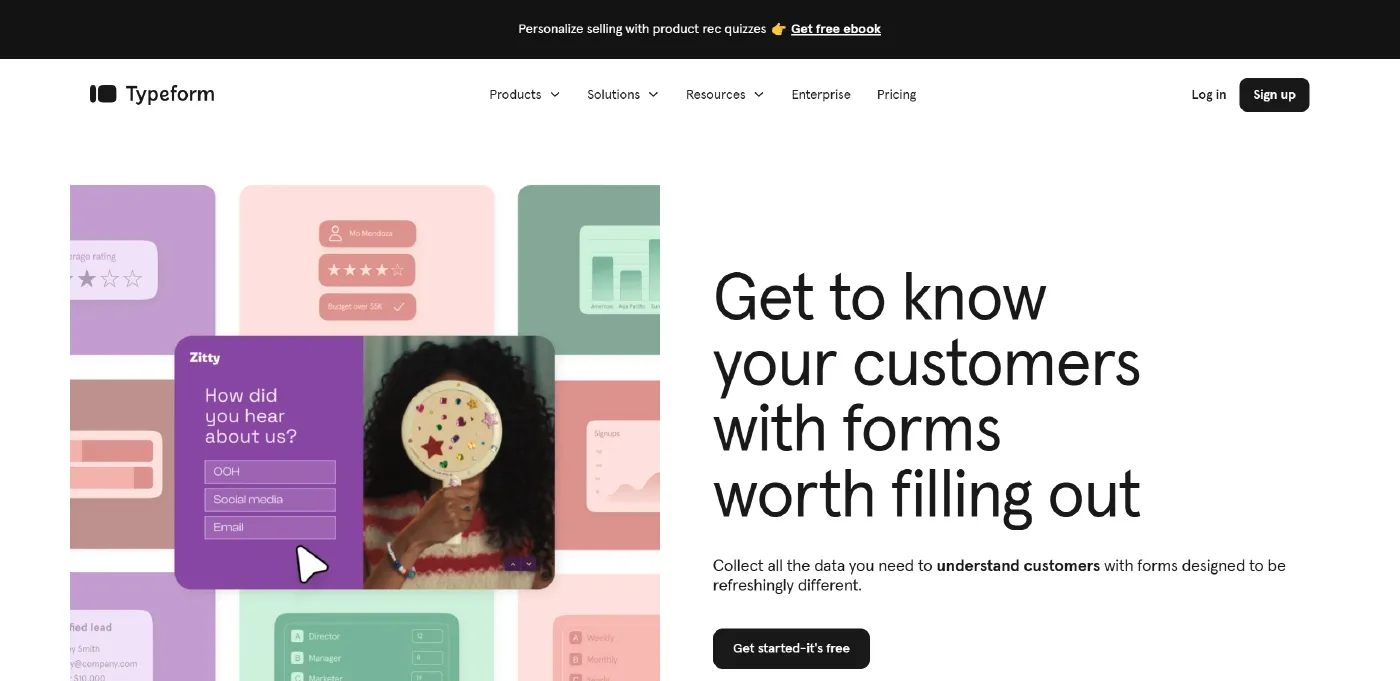
Typeform is a unique tool for creating interactive forms and surveys that capture leads while keeping visitors engaged. Its sleek and user-friendly interface encourages higher completion rates compared to traditional forms.
With Typeform, you can design customizable forms that match your brand. The platform’s conversational format allows you to ask one question at a time, making the experience feel more personal and engaging.
Typeform is especially useful for collecting detailed information from leads, such as preferences, feedback, or survey responses. It integrates with tools like HubSpot, Salesforce, and Google Sheets, so your data is automatically synced and ready for action.
Whether you’re running a lead generation campaign or conducting market research, Typeform’s versatility makes it a valuable addition to your toolkit.
Graphic Creation Tools You Should Use in 2025
Creating visually appealing graphics is essential for any marketer in 2025. Whether it’s for social media posts, infographics, presentations, or ads, great visuals help your message stand out. Fortunately, you don’t need to be a professional designer to create high-quality visuals. Graphic creation tools make it easy to design stunning content quickly and efficiently.
Related Article: Best Graphic Design Tools: Essential Resources for Creatives
Here, we’ll explore five powerful graphic creation tools that can elevate your marketing efforts. These tools cater to all skill levels, ensuring anyone can create professional-looking designs with ease. So, let’s check them out with us!
31. Canva

Canva is one of the most popular graphic creation tools for good reason. It is beginner-friendly, versatile, and packed with features that cater to marketers, small businesses, and even large organizations. Canva’s drag-and-drop interface makes it incredibly easy to design graphics, even if you have no prior experience.
With Canva, you can access thousands of pre-designed templates for everything from social media posts and flyers to business cards and presentations. These templates are fully customizable, allowing you to tweak colors, fonts, and images to match your brand’s style.
Additionally, Canva offers a robust free plan, and its premium version unlocks extra features like the Brand Kit, which ensures your designs stay consistent with your company’s visual identity. So, if you’re designing a quick Instagram post or a detailed marketing presentation, Canva will make the process fast and enjoyable for you.
32. Adobe Spark
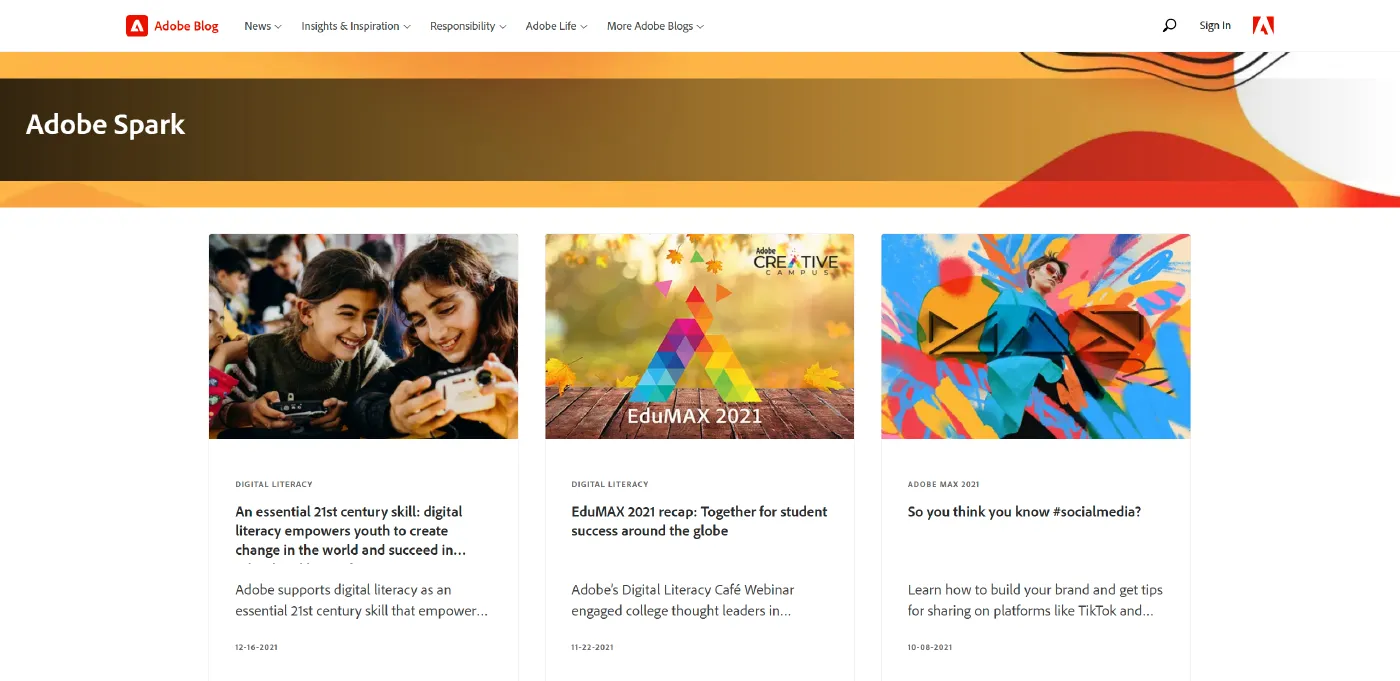
Adobe Spark is another excellent tool for quickly creating professional-quality graphics. It’s part of Adobe’s ecosystem, so it works seamlessly with other Adobe products if you’re already familiar with tools like Photoshop or Illustrator. However, Adobe Spark is much simpler to use, making it accessible even to those without design experience.
Adobe Spark offers a variety of features to create social media posts, videos, and web pages. Its templates and themes are designed to help you start projects quickly. One of its standout features is text animation, which allows you to add dynamic text effects to your visuals for an eye-catching result.
Moreover, Adobe Spark’s mobile app ensures that you can create on the go, making it an ideal choice for busy marketers. Its ability to integrate with your brand’s colors and fonts ensures that all your content stays visually cohesive.
33. Crello (Now VistaCreate)
Crello, rebranded as VistaCreate, is a fantastic tool for creating graphics, particularly for social media. It’s similar to Canva but offers a unique focus on animations, making it perfect for marketers who want to create engaging, dynamic content.
With VistaCreate, you can choose from over 50,000 templates for various types of content, including social media posts, ads, banners, and more. The animation maker allows you to add movement to your graphics, making them more engaging for viewers. The platform also provides access to a large library of free images, videos, and icons, which you can use to customize your designs.
VistaCreate’s intuitive design interface makes it easy for anyone to produce professional-looking visuals. Whether you’re a solo entrepreneur or part of a marketing team, this tool helps you create compelling graphics with minimal effort.
34. Figma
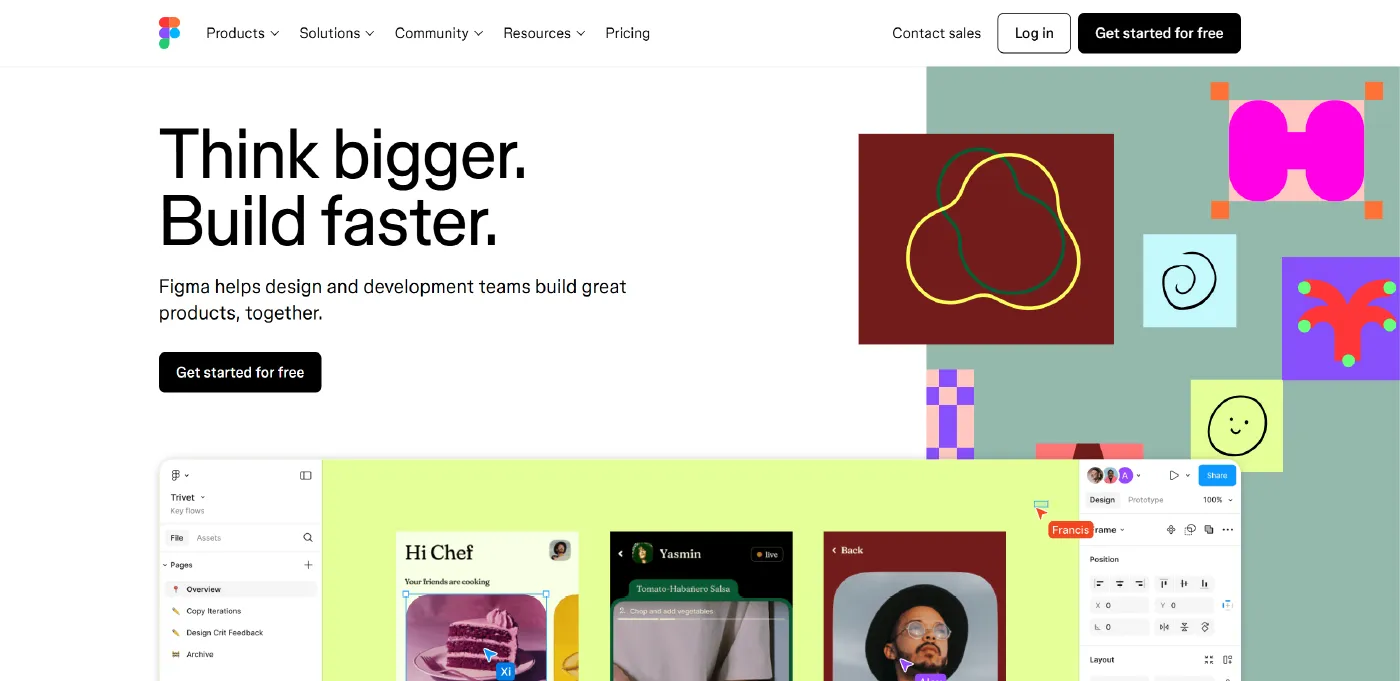
Figma is a collaborative design tool widely used by professionals to create user interfaces and prototypes. While it’s more advanced than other tools on this list, it’s incredibly versatile and ideal for marketers involved in web or app design projects.
One of Figma’s key features is its real-time collaboration. Multiple team members can work on the same design project simultaneously, making it a great tool for brainstorming and feedback. It also allows you to create interactive prototypes, helping you showcase website or app designs before they’re live.
Even though Figma is primarily aimed at designers, marketers can use it to create stunning web graphics, wireframes, and even presentations. Its cloud-based platform means you can access your projects from anywhere, making it convenient for remote teams.
People Also Read: Graphic Designer Skills: Essential Abilities for Success
35. Visme
Visme is a versatile tool that combines graphic creation with data visualization. It’s perfect for creating infographics, presentations, reports, and other marketing materials that require visual storytelling.
Visme’s infographic templates are particularly impressive, allowing you to present complex data in a clear and visually appealing way. The platform also offers a range of customizable charts, graphs, and widgets, making it easy to turn numbers into engaging visuals.
Additionally, Visme’s presentation builder is a powerful alternative to traditional tools like PowerPoint. Its drag-and-drop editor lets you create professional presentations that stand out. Visme also includes branding tools to ensure your designs align with your company’s identity.
In conclusion, using the right tools is essential to stay ahead of the competition. From social media management and email marketing to SEO, these tools offer excellent functionality to streamline workflows and enhance results. So, embrace the power of these tools to enhance your marketing efforts and achieve your goals in 2025!
FAQs
What are the 7 types of digital marketing?
The 7 types of digital marketing include SEO, content marketing, social media marketing, email marketing, PPC advertising, affiliate marketing, and influencer marketing.
What are the top 5 digital marketing platforms?
The top 5 digital marketing platforms are Google Ads, Facebook Ads, Instagram, LinkedIn, and YouTube, offering powerful tools for advertising, engagement, and audience targeting across various industries.
What are 5 examples of digital marketing?
Five examples of digital marketing are SEO optimization, social media advertising, email campaigns, PPC ads on Google, and content marketing.
